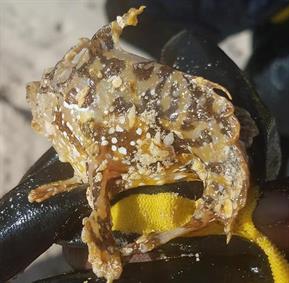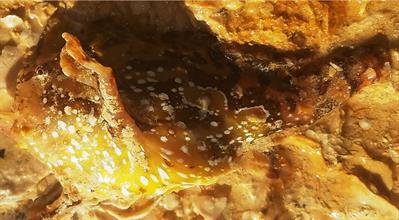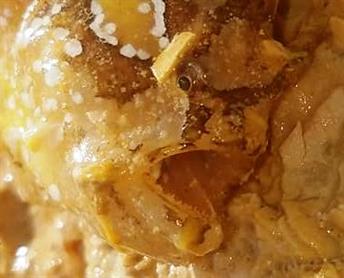



Histrio histrio
| Ecological Descriptors |
||||
| Habitat | Size | Diet | Behaviour | Sex |
| Sargassum, (Man, seagrass) | 20 | Pisc, Cru | I | F |
Note:
Large ingresses of Sargassum (especially S. natans type VIII) have been arriving in Antigua since 2011, hence this species may become more frequently seen.
Description:
Globular, smooth, compressed body, with a large upward pointing mouth and with eyes on side of head. Limb-like pectoral fins with an "elbow" joint, so that the fin itself is not connected to body. Long pelvic fins. Various colours from brown, to olive, to yellow with a covering of pale spots and darker brown mottling. Numerous fleshy tabs . Fishing pole on head is 1/2 length of the 2nd dorsal spine and the terminal lure is oval, with numerous parallel folds, a cluster of short filaments at its base.
Ecology
Solitary ambush predator relying on both colouration and fleshy tabs for camouflage within the Sargassum rafts in which it usually lives - however has also (elsewhere) been reported in association with other floating objects, mangoves and seagrass beds. Uses lure on the end of a "fishing pole" on head to attract prey nearer.
Commonly blown into shore and bay waters during storms or mass Sargassum beachings. They feed on fishes and shrimps that seek refuge in the floating weeds.
Life Cycle
Oviparous. Eggs are bound in ribbon-like sheath or mass of gelatinous mucus called 'egg raft' or 'veil' . During courtship, the male follows the female closely then both rush to the surface to spawn. At this point, eggs are produced in a gelatinous floating mass or 'raft' and inseminated by the male. The eggs remain embedded in this raft until hatching.
Large ingresses of Sargassum (especially S. natans type VIII) have been arriving in Antigua since 2011, hence this species may become more frequently seen.
Description:
Globular, smooth, compressed body, with a large upward pointing mouth and with eyes on side of head. Limb-like pectoral fins with an "elbow" joint, so that the fin itself is not connected to body. Long pelvic fins. Various colours from brown, to olive, to yellow with a covering of pale spots and darker brown mottling. Numerous fleshy tabs . Fishing pole on head is 1/2 length of the 2nd dorsal spine and the terminal lure is oval, with numerous parallel folds, a cluster of short filaments at its base.
Ecology
Solitary ambush predator relying on both colouration and fleshy tabs for camouflage within the Sargassum rafts in which it usually lives - however has also (elsewhere) been reported in association with other floating objects, mangoves and seagrass beds. Uses lure on the end of a "fishing pole" on head to attract prey nearer.
Commonly blown into shore and bay waters during storms or mass Sargassum beachings. They feed on fishes and shrimps that seek refuge in the floating weeds.
Life Cycle
Oviparous. Eggs are bound in ribbon-like sheath or mass of gelatinous mucus called 'egg raft' or 'veil' . During courtship, the male follows the female closely then both rush to the surface to spawn. At this point, eggs are produced in a gelatinous floating mass or 'raft' and inseminated by the male. The eggs remain embedded in this raft until hatching.
Sargassumfish


Synonym:
Sargassum Fish
Sargassum Fish

(C) NOAA



Sargassumfish
Sargassumfish
Sargassumfish
472

473
474





